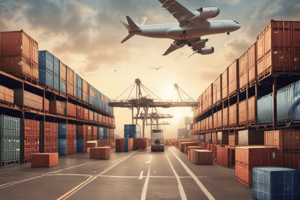Podcast
Questions and Answers
What is a common cause of supply chain disruption in the shipping industry?
What is a common cause of supply chain disruption in the shipping industry?
- Increase in oil prices
- Implementation of new regulations
- Natural disasters such as hurricanes (correct)
- Changes in global trade patterns
What is a potential consequence of non-compliance with regulations in the shipping industry?
What is a potential consequence of non-compliance with regulations in the shipping industry?
- Increased revenue and profitability
- Reduced costs for compliance and auditing
- Improved reputation and customer relationships
- Fines and penalties (correct)
What is a factor that can contribute to freight rate volatility?
What is a factor that can contribute to freight rate volatility?
- Increase in demand for shipping services
- Stable oil prices
- Implementation of new regulations
- Changes in global trade patterns (correct)
What is a high-risk area for marine piracy?
What is a high-risk area for marine piracy?
What is a potential effect of supply chain disruption on a shipping company's operations?
What is a potential effect of supply chain disruption on a shipping company's operations?
What is a regulatory compliance risk in the shipping industry?
What is a regulatory compliance risk in the shipping industry?
What is a mitigation strategy for marine piracy?
What is a mitigation strategy for marine piracy?
What is a consequence of freight rate volatility for a shipping company?
What is a consequence of freight rate volatility for a shipping company?
What is the main cause of accidents in the shipping industry, according to statistics?
What is the main cause of accidents in the shipping industry, according to statistics?
What is a consequence of port congestion on a shipping company's operations?
What is a consequence of port congestion on a shipping company's operations?
What is the purpose of international conventions such as MARPOL, SOLAS, and STCW in the shipping industry?
What is the purpose of international conventions such as MARPOL, SOLAS, and STCW in the shipping industry?
What type of insurance coverage is designed to protect against losses due to war, piracy, and terrorism?
What type of insurance coverage is designed to protect against losses due to war, piracy, and terrorism?
What is a common type of cargo theft in the shipping industry?
What is a common type of cargo theft in the shipping industry?
What is a risk management strategy that involves identifying and evaluating potential risks?
What is a risk management strategy that involves identifying and evaluating potential risks?
What is a consequence of non-compliance with regulatory requirements in the shipping industry?
What is a consequence of non-compliance with regulatory requirements in the shipping industry?
What is a measure that can be taken to mitigate the risk of equipment failure in the shipping industry?
What is a measure that can be taken to mitigate the risk of equipment failure in the shipping industry?
Study Notes
Shipping Business Risk
Supply Chain Disruption
- Events that disrupt the normal flow of goods, services, or information from supplier to customer
- Causes:
- Natural disasters (e.g. hurricanes, earthquakes)
- Labor disputes or strikes
- Equipment or infrastructure failures
- Cyber attacks
- Trade wars or tariffs
- Effects:
- Delays or cancellations of shipments
- Increased costs (e.g. demurrage, detention)
- Reduced revenue and profitability
- Damage to reputation and customer relationships
Regulatory Compliance
- Adherence to laws, regulations, and standards governing the shipping industry
- Examples:
- International Maritime Organization (IMO) regulations
- Customs and border protection regulations
- Environmental regulations (e.g. ballast water management)
- Safety and security protocols
- Risks:
- Fines and penalties for non-compliance
- Detention or seizure of vessels
- Reputation damage and loss of business
- Increased costs for compliance and auditing
Freight Rate Volatility
- Unpredictable changes in freight rates, affecting revenue and profitability
- Causes:
- Fluctuations in supply and demand
- Changes in global trade patterns
- Oil price volatility
- Currency exchange rate fluctuations
- Effects:
- Unstable revenue streams
- Difficulty in budgeting and forecasting
- Increased risk of default or insolvency
- Reduced competitiveness in the market
Marine Piracy
- Robbery or illegal violence at sea, often targeting commercial vessels
- Risks:
- Theft of cargo or vessel
- Ransom demands
- Injury or death to crew members
- Damage to vessel or equipment
- High-risk areas:
- Gulf of Aden
- Indian Ocean
- Malacca Strait
- West African coast
- Mitigation strategies:
- Armed guards or security personnel
- Avoidance of high-risk areas
- Implementation of Best Management Practices (BMP)
- Cooperation with naval authorities and international organizations
Shipping Business Risk
Supply Chain Disruption
- Disruptions to the normal flow of goods, services, or information from supplier to customer
- Causes: natural disasters, labor disputes, equipment failures, cyber attacks, and trade wars
- Effects: shipment delays, increased costs, reduced revenue, and damage to reputation and customer relationships
Regulatory Compliance
- Adherence to laws, regulations, and standards governing the shipping industry
- Examples: IMO regulations, customs regulations, environmental regulations, and safety and security protocols
- Risks: fines, detention, reputation damage, and increased costs for compliance
Freight Rate Volatility
- Unpredictable changes in freight rates affecting revenue and profitability
- Causes: supply and demand fluctuations, global trade pattern changes, oil price volatility, and currency exchange rate fluctuations
- Effects: unstable revenue streams, budgeting difficulties, increased risk of default, and reduced competitiveness
Marine Piracy
- Robbery or illegal violence at sea, targeting commercial vessels
- Risks: cargo theft, ransom demands, injury or death to crew, and vessel damage
- High-risk areas: Gulf of Aden, Indian Ocean, Malacca Strait, and West African coast
- Mitigation strategies: armed guards, avoidance of high-risk areas, implementation of BMP, and cooperation with naval authorities
Shipping Business Risks
Navigation Risks
- 75-96% of accidents caused by human error
- Weather conditions such as storms, fog, and icebergs can cause shipwrecks
- Equipment failures, including engine, steering, and navigation system failures, can lead to accidents
- Piracy involves hijacking, theft, and violence against crew and cargo
Port Congestion
- Delays occur due to waiting times for berths, cargo handling, and customs clearance
- Increased costs include demurrage, detention, and storage fees
- Reduced efficiency leads to lower productivity and vessel utilization
- Safety risks increase due to accidents and collisions in congested ports
Regulatory Compliance
- International conventions: MARPOL (marine pollution), SOLAS (safety of life at sea), and STCW (standards of training, certification, and watchkeeping)
- National regulations include customs, tax, and immigration laws
- Industry standards include ISO (International Organization for Standardization), OCIMF (Oil Companies International Marine Forum), and ICS (International Chamber of Shipping)
- Non-compliance results in fines, penalties, and reputational damage
Marine Insurance
- Hull and machinery insurance covers physical damage to vessels
- Cargo insurance covers loss or damage to goods in transit
- Liability insurance covers third-party claims and damages
- War risk insurance covers losses due to war, piracy, and terrorism
Cargo Theft
- High-value cargo such as electronics, pharmaceuticals, and luxury goods are targets for theft
- Entire containers can be hijacked or pilfered
- Cargo is exposed to weather, handling, and transit risks, leading to damage
- Fraudulent activities include misdeclaration, mislabeling, and cargo tampering
Natural Disasters
- Hurricanes, typhoons, and cyclones cause damage to vessels and shore-based infrastructure
- Tsunamis and earthquakes cause damage to vessels, ports, and coastal infrastructure
- Floods and storms cause damage to cargo, vessels, and shore-based infrastructure
- Climate change leads to rising sea levels, increased storm frequency, and changing weather patterns
Risk Management
- Risk assessment involves identifying and evaluating potential risks
- Risk mitigation involves implementing controls and measures to reduce risks
- Risk transfer involves insurance, outsourcing, and diversification
- Risk monitoring and review involves ongoing evaluation and adjustment of risk management strategies
Studying That Suits You
Use AI to generate personalized quizzes and flashcards to suit your learning preferences.
Description
Learn about the various events that can disrupt the flow of goods and services, their causes, and their effects on the shipping business, including delays, increased costs, and reputational damage.




